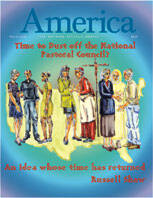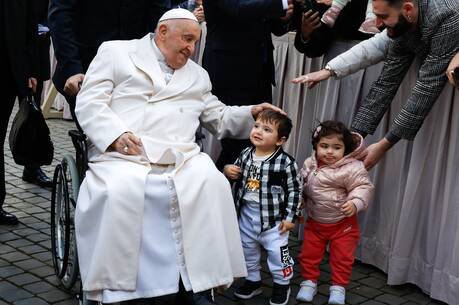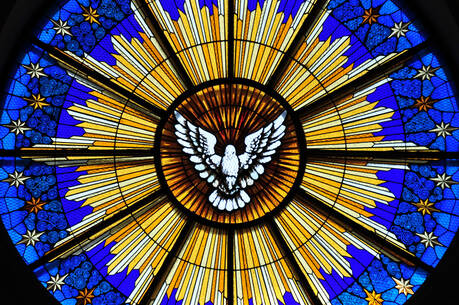Has the time come to revive the idea of a national pastoral council for the Catholic Church in the United States a quarter-century after the scheme was effectively abandoned? Opinions will differ on that. But two events this year are reminders that establishing some such body really is part of the unfinished business of the postconciliar era.
On July 1, 2001, the National Conference of Catholic Bishops and the United States Catholic Conference will cease to exist, and a new, single entity called the United States Conference of Catholic Bishops will take their place. October will bring the 25th anniversary of the famous Call to Action conference held in Detroit. The idea of a national pastoral council is bound up with all of these things. A little history makes it clear how that is so.
From World War I until the 1960’s, the bishops sponsored an agency called the National Catholic Welfare Conference to coordinate their voluntary cooperation at the national level. It was replaced in 1966, immediately after the Second Vatican Council, by the N.C.C.B. and the U.S.C.C..
An unusual feature of the new institution was its dual-conference structure. N.C.C.B. was the episcopal conference mandated by Vatican II, through which the bishops were to collaborate with one another in carrying out the pastoral agenda set for them by the council. As for U.S.C.C., it often was said that it was intended to represent the social action interests of the bishops. This was true up to a point, but there was more to it than that.
U.S.C.C. was indeed N.C.C.B.’s “social action” twin, with departments responsible for education, communications and what in time came to be called social development and world peace. But the U.S.C.C. also was envisaged by its creators as a nucleus from which in time a national pastoral council would evolve as the embodiment of the “shared responsibility” for the church celebrated during and after the council.
The fundamental idea of shared responsibility was that priests, deacons, religious and lay people would collaborate with the bishops in specified areas of decision making. In the United States Cardinal John Dearden of Detroit, the first president of N.C.C.B./U.S.C.C., was a leading proponent of the idea.
As a step in the direction of shared responsibility, non-bishops served along with bishops as voting members of the policy-formulating committees for the three U.S.C.C. departments. This arrangement was unlike the composition of N.C.C.B. committees, where only bishops had the vote. Another, potentially more important step was taken in 1969 with the establishment of a national advisory council composed of bishops and non-bishops to exercise oversight over U.S.C.C. and its civic-political agenda. “A functioning advisory council was seen as a hoped-for instance of shared responsibility in the church at the national level,” Cardinal Dearden wrote in 1975.
One of the advisory council’s first assignments was a feasibility study of a national pastoral council. The study culminated in a conference held at Mundelein College, Chicago, in August 1970, with 101 dioceses and 36 national organizations represented. The advisory council reported to the bishops the following year that a national pastoral council was desirable but not immediately feasible—more spadework was needed before going ahead.
In January 1973, however, the Vatican’s Congregation for the Clergy sent the world’s bishops a letter saying national pastoral councils were not opportune. The letter was apparently occasioned by the performance of the Dutch pastoral council in controversial events then unfolding in The Netherlands under the rubric of “renewal.” Very likely the letter also was in response to the feasibility study in the United States.
But the N.P.C. idea was not dead. The advisory council had proposed that such a body be up and running by the time of the U.S. bicentennial in 1976. The bishops in 1973 established a bicentennial committee under Cardinal Dearden to plan for Catholic participation in the national celebration. The centerpiece of the program turned out to be the Call to Action conference. In retrospect, it appears to have been an attempt to reintroduce the N.P.C. concept by the back door. But it had the opposite result.
A majority of the 1,300 delegates who gathered on Oct. 21-23 in Detroit were employed by church agencies. In his memoirs, the conservative writer Russell Kirk, who was there, mischievously calls them “church mice.” If the description is accurate, then these were church mice who were feeling their oats. In resolutions that ranged from birth control to the arms race, they advocated women’s ordination, married priests, admission of divorced and remarried Catholics to the sacraments, a national arbitration board that could undo bishops’ decisions, and a great deal else.
The historian David O’Brien of Holy Cross College, one of the planners of the bishops’ bicentennial program, writes: “The democratic process, which saw a lay person having the same vote as a bishop, and the progressive nature of the resolutions made many members of the hierarchy nervous, so that its results were more or less shelved”—along with the idea of a national pastoral council.
Even so, the germ of the N.P.C. scheme continued to exist for the last quarter-century in the United States Catholic Conference, with its mixed-membership commitees, and in the behind-the-scenes functioning of the National Advisory Council. As of July 1, much of that will change.
A Unified Entity
The reorganization plan was developed by a process initially headed by the late Cardinal Joseph Bernardin of Chicago and continued under Archbishop Daniel Pilarczyk of Cincinnati. The Holy See has formally approved it. The plan does away with the old dual-conference N.C.C.B./U.S.C.C. structure and puts in its place a unitary entity, the United States Conference of Catholic Bishops, as the episcopal conference of the United States. Its program and its staff of laity, religious and priests will look very much as they have in the past; the National Advisory Council will continue to operate. But the U.S.C.C.B will limit voting membership on its committees to bishops, with non-bishops as consultants only.
There may be good reasons for establishing this kind of “pure” episcopal conference, and the change is unlikely to have much visible impact on Catholic life in America anyway. But whether anyone is paying attention or not, it marks a further move away from the postconciliar ideal of shared responsibility. That in itself is a reason to revisit the idea of a national pastoral council now. There are others.
One lies in the fact that the civic and political effectiveness of the Catholic community in the United States falls far short of what its size would suggest. About one American in every four is a Catholic, yet on issues from abortion to capital punishment, educational vouchers to family, this body of some 63 million does not have an impact on public policy commensurate with its numbers.
There are many reasons for that. Lack of an effective national structure through which Catholics who are not bishops can participate in formulating and representing the church’s views on public policy is one. As matters stand, on many political issues the bishops resemble generals without troops. The United States Conference of Catholic Bishops, as a “pure” bishops’ organization, is hardly likely to improve this situation.
Other good purposes might also be served by establishing a national pastoral council. It could, for example, help Catholics get beyond sterile debates about the seamless garment and the common ground by participating together in purposeful dialogue about real policy issues. It might also give a boost to ecumenical relations, especially with the Orthodox and the Anglicans, by serving as a practical step in the direction of a synodal process for decision-making.
Much consultation, discussion and careful planning would have to precede the creation of any such body in order to avoid earlier mistakes. The concerns of the Holy See and the implications for the church elsewhere should be respected. It would be important to weigh the meaning of the fact that the Code of Canon Law provides for diocesan pastoral councils but is silent about national counterparts. Among the matters needing particularly close attention are these:
• The makeup of a national pastoral council. A body like this should not be overloaded with middle-echelon church bureaucrats, as happened at the Call to Action conference. Clear norms would have to be established regarding things like categories of membership and method of selection.
• The agenda of a national pastoral council. Should it be limited to public policy questions or should it also consider matters pertaining to the internal life of the church? At the very least, a go-slow approach would be in order, lest the National Pastoral Council repeat Call to Action’s mistake of speaking too quickly about too much.
• The weight carried by decisions of a national pastoral council. In Novo Millennio Ineunte, his apostolic letter for the close of the Jubilee Year, Pope John Paul II mentions pastoral councils—presumably diocesan—among the “structures of participation” that deserve to be encouraged for the sake of ecclesial communion. He says such bodies are “consultative rather than deliberative,” but no less “meaningful and relevant” on that account (No. 45).
•Thought also should be given to the possibility of creating in due time a local-state-national network of pastoral councils. Plainly, the National Pastoral Council would be a more effective, meaningful body if linked to the grassroots.
Novo Millennio Ineunte strongly commends “the ancient pastoral wisdom which, without prejudice to their authority, encouraged pastors to listen more widely to the entire people of God.” Where a national pastoral council is concerned, there is a great deal to talk about. The coming of the United States Conference of Catholic Bishops and the 25th anniversary of Call to Action make this the right time to begin that conversation.








